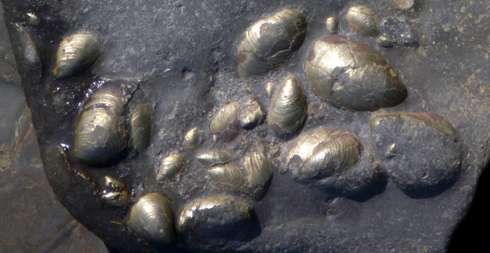Fossils used to predict impact of global warming on marine life

Researchers have identified the key environmental impacts on marine animals during natural global warming in the early Jurassic, 183 million years ago.
These results could predict the future of modern marine ecosystems under climate change.
The team found that spreading 'dead zones' of oxygen-poor waters near the sea bed led to the extinction of species. The research was led by Museum palaeontologist Prof Richard Twitchett and colleagues Dr Silvia Danise from Plymouth and Dr Cris Little from Leeds.
'Spreading oxygen-poor dead zones is widely acknowledged as a major threat to modern shelf seas. It is happening now,' said Prof Twitchett. 'This is driven by climate change but also by excess nutrient input from human land use.'
The addition of nutrients to the sea, for example by run-off from farming, causes blooms of algae. When these die and sink they strip oxygen from the water, impacting animals that swim in the water column. This phenomenon occurred naturally during the early Jurassic, as climate change caused more nutrients to be washed into the oceans.
In-depth impacts
The team looked at more than 11,000 fossils from 66 species at 99 points in time to build an ambitious analysis. The first of its kind, the study applied a mathematical approach widely used in ecological and medical studies, but never before used to analyse a past extinction event.
'This approach allowed us to compare the fossil record with chemical evidence from the rocks to determine which environmental factors were the most important drivers of marine ecosystem change,' said Dr Danise, who ran the analysis.
They found that animals living on the sea bed and in the water column responded differently to the environmental impacts, and the two ecosystems became less connected to each other as a result of the changes in climate.
The temperature of the water itself was found to have little impact on the animals. Instead, global warming had knock-on effects that caused extinctions, such as increased nutrient input which fuelled the algal blooms that stripped the oxygen from the water column.
Experimenting with the past
Global warming causes a complex set of environmental changes, and predicting how ecosystems will respond is a major challenge. We cannot run huge experiments with whole ecosystems to find the answers, but analyses of past events like this one can provide us with valuable clues.
'Although there are obvious differences between past events and the modern, in terms of things like the actual species present, the key observation is that we see similar ecological changes happening again and again in response to similar environmental changes through time,' said Prof Twitchett. 'This strongly suggests that similar responses will occur again in the future.'
More information: "Environmental controls on Jurassic marine ecosystems during global warming." Geology, March 2015, v. 43, p. 263-266, DOI: 10.1130/G36390.1
Journal information: Geology
Provided by Natural History Museum




















